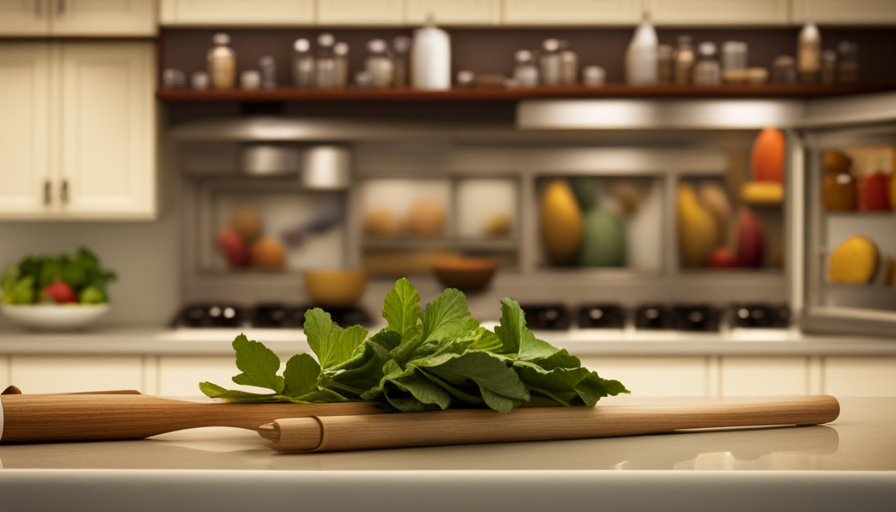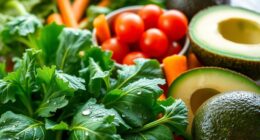Becoming a certified raw food nutritionist is akin to setting off on a delightful and wholesome voyage, where you delve into the potency of raw, unprocessed foods in rejuvenating and nurturing the body. With this certification, you have the opportunity to introduce others to the incredible advantages of a raw food regimen and steer them towards a healthier way of living.
In order to become a certified raw food nutritionist, it is essential to invest time and effort into gaining the necessary knowledge and skills. This involves researching accredited raw food nutrition programs and choosing the right certification program that aligns with your goals and values.
Completing the required coursework and training is a crucial step towards certification. It is also important to gain hands-on experience through internships or volunteering opportunities, as this will enhance your understanding of raw food nutrition and provide valuable practical skills.
Maintaining your certification through continuing education is necessary to stay updated on the latest research and trends in raw food nutrition. Joining professional associations and networks can also provide valuable resources and networking opportunities to help you grow your career as a raw food nutritionist.
Are you ready to embark on this exciting journey towards becoming a certified raw food nutritionist? Let’s dive in and explore the path to a fulfilling and rewarding career in this field.
Key Takeaways
- Research and choose an accredited raw food nutrition program that fits your needs and goals.
- Complete coursework and training to gain the necessary knowledge and skills for certification.
- Gain hands-on experience through internships or volunteering to enhance your practical skills.
- Join professional associations and networks to access valuable resources and networking opportunities for career growth.
Understand the Benefits of a Raw Food Diet
Imagine enjoying a vibrant and energizing lifestyle while nourishing your body with the abundant benefits of a raw food diet. A raw food diet consists of consuming unprocessed, uncooked fruits, vegetables, nuts, seeds, and sprouted grains.
By adopting this lifestyle, you can experience improved digestion, increased energy levels, enhanced mental clarity, and strengthened immune function.
One of the major benefits of a raw food diet is weight loss. Raw food diet recipes are typically low in calories and high in fiber, which can help you shed those extra pounds. Additionally, raw foods are rich in enzymes, which aid in digestion and metabolism, further supporting weight loss efforts.
Researching accredited raw food nutrition programs is the next step in becoming a certified raw food nutritionist. These programs provide comprehensive education on the principles and benefits of a raw food diet, as well as guidance on creating balanced meal plans and preparing raw food recipes.
By enrolling in an accredited program, you can gain the knowledge and skills necessary to assist others in achieving optimal health through a raw food diet.
Research Accredited Raw Food Nutrition Programs
To start your journey towards expertise in the field of raw food nutrition, you should explore accredited programs that are like a compass guiding you through the vast sea of knowledge.
Accredited programs offer a structured curriculum that equips you with the necessary skills and knowledge to become a certified raw food nutritionist. These programs are designed to provide a comprehensive understanding of the benefits and principles of a raw food diet, as well as the science behind it.
By enrolling in an accredited program, you gain access to experienced instructors who are experts in the field of raw food nutrition. They’ll guide you through the coursework, ensuring that you develop a deep understanding of the subject matter. Additionally, these programs often offer practical training, allowing you to apply your knowledge in real-life scenarios.
Completing an accredited raw food nutrition program opens up a world of opportunities for raw food nutrition careers. Whether you aspire to work as a nutrition consultant, health coach, or even start your own raw food business, a certification from an accredited program will give you the credibility and expertise needed to succeed.
As you explore accredited programs, consider factors such as program length, cost, and curriculum. Look for programs that align with your career goals and offer a well-rounded education in raw food nutrition. By choosing the right raw food nutrition certification program, you can take the next step towards fulfilling your passion for promoting health and wellness through a raw food diet.
Choose the Right Raw Food Nutrition Certification Program
Enrolling in an accredited raw food nutrition program will provide you with the necessary skills and knowledge to choose the right certification program for your career goals. Choosing the right certification program is crucial in ensuring that you receive a reputable and recognized qualification in the field of raw food nutrition.
To find reputable nutritionists who can guide you in your decision, it’s important to do thorough research. Look for professionals who’ve established themselves in the industry and have a good reputation. Read reviews and testimonials from their past students to get a sense of their teaching style and the quality of education they provide.
Consider the curriculum offered by different certification programs. Look for programs that cover a wide range of topics such as raw food principles, food safety, menu planning, and the science behind raw food nutrition. Additionally, check if the program offers practical training or internships, as these hands-on experiences can greatly enhance your learning.
Taking these factors into account, you can choose the right raw food nutrition certification program that aligns with your career goals and provides you with the necessary skills and knowledge to succeed in the field. Completing the required coursework and training will further enhance your expertise in raw food nutrition and prepare you for the challenges and opportunities that lie ahead in your career.
Complete the Required Coursework and Training
Once you’ve chosen the right raw food nutrition certification program, it’s time to dive into the required coursework and training. This will equip you with the necessary skills and knowledge to excel in this field. Interestingly, research shows that individuals who complete practical training or internships alongside their coursework have a 20% higher chance of securing employment in the raw food nutrition industry.
To successfully complete the required coursework and training, here are three key steps to follow:
-
Attend lectures and participate in discussions: The coursework will cover various topics such as raw food principles, plant-based nutrition, food safety, and menu planning. Attending lectures and actively participating in discussions will help you grasp the concepts better and engage with fellow students and instructors.
-
Complete assignments and projects: Coursework often includes assignments and projects that allow you to apply your knowledge to real-life scenarios. These tasks may involve creating meal plans, conducting research, or analyzing case studies. Completing these assignments will enhance your understanding and problem-solving skills.
-
Participate in practical training or internships: Practical training or internships provide hands-on experience in the field. This opportunity allows you to work alongside experienced professionals, gain practical skills, and apply what you’ve learned in a real-world setting.
By completing the required coursework and training, you’ll be well-prepared to gain hands-on experience through internships or volunteering.
Gain Hands-on Experience through Internships or Volunteering
Get ready to dive into the world of raw food nutrition by gaining valuable hands-on experience through internships or volunteering. Finding internships and volunteering opportunities for raw food nutritionists is a great way to develop practical skills in raw food nutrition through hands-on experience. These opportunities allow you to work alongside experienced professionals in the field, learn from their expertise, and apply your knowledge in real-life situations.
To find internships or volunteering opportunities, start by reaching out to local raw food restaurants, wellness centers, or health food stores. Many of these establishments may offer internships or be willing to accept volunteers who are passionate about raw food nutrition. You can also consider contacting raw food nutritionists directly to inquire about any available opportunities or to ask if they would be open to mentoring you.
Once you have secured an internship or volunteering position, make the most of your experience by actively participating and asking questions. Take this opportunity to observe and assist with meal preparation, menu planning, and client consultations. This hands-on experience will help you develop practical skills, gain confidence in your abilities, and deepen your understanding of raw food nutrition.
With your hands-on experience in raw food nutrition, you’ll be well-prepared to take the next step and pass the certification exam.
Pass the Certification Exam
Successfully passing the certification exam is like unlocking the door to endless opportunities in the world of raw food nutrition, allowing me to showcase my expertise and open the pathway to a fulfilling career. To ensure success on the certification exam, proper exam preparation is essential. Here are four key steps to help me prepare for the exam:
-
Familiarize myself with the exam format and content: Understanding the structure of the exam and the topics that will be covered will enable me to focus my studying and allocate my time effectively.
-
Gather study materials: Utilizing reliable study materials such as textbooks, online resources, and practice exams will help me gain a comprehensive understanding of raw food nutrition and prepare me for the types of questions I may encounter on the exam.
-
Create a study schedule: Developing a study schedule will help me stay organized and ensure that I cover all the necessary material before the exam. Breaking down the content into manageable sections and setting realistic study goals will enhance my preparation.
-
Practice, practice, practice: Taking practice exams under exam-like conditions will not only help me become familiar with the format but also identify areas where I may need to focus my studying. Reviewing the answers and understanding any mistakes will allow me to learn from them and improve my performance.
By effectively preparing for the certification exam, I can confidently demonstrate my knowledge and skills in raw food nutrition. Once certified, it’s important to maintain certification through continuing education to stay up-to-date with the latest research and developments in the field.
Maintain Certification through Continuing Education
Continuing to learn and grow in my field is crucial for staying at the forefront of new research and advancements, ensuring that I can provide the best possible care and support to those seeking advice on healthy eating. As a certified raw food nutritionist, it’s important to stay updated on the latest developments in the field of nutrition, especially when it comes to the benefits of a raw food diet.
Continuing education allows me to deepen my understanding of the science behind raw food nutrition and expand my knowledge base. One of the main benefits of a raw food diet is its high nutrient content. Raw fruits, vegetables, nuts, and seeds are packed with essential vitamins, minerals, and enzymes that can support optimal health. By staying up-to-date with continuing education, I can learn about new research and advancements in the field, allowing me to provide the most accurate and effective advice to my clients.
Additionally, continuing education helps me stay informed about the latest trends and developments in the raw food community. It allows me to connect with other professionals in the field, share knowledge, and collaborate on new ideas. By joining professional associations and networks, I can further expand my professional network and gain access to valuable resources and opportunities.
Transitioning into the next section about joining professional associations and networks, I recognize the importance of building connections with like-minded individuals in the field.
Join Professional Associations and Networks
By connecting with like-minded professionals in your field through joining professional associations and networks, you can tap into a community of knowledge and support that will empower you to thrive and grow as a passionate advocate for healthy eating. Being part of these professional organizations offers numerous benefits for your professional development as a certified raw food nutritionist.
Here are some key advantages of joining professional associations and networks:
-
Access to valuable resources: Professional associations provide access to a wealth of resources such as research papers, articles, and industry trends that can enhance your knowledge and expertise in raw food nutrition.
-
Networking opportunities: These associations and networks offer opportunities to connect with other professionals in the field, allowing you to exchange ideas, learn from their experiences, and potentially collaborate on projects.
-
Continuing education: Many associations offer workshops, conferences, and webinars that provide ongoing education and help you stay up-to-date with the latest developments in raw food nutrition.
-
Mentorship and guidance: Professional associations often have mentorship programs where experienced professionals can guide and support you in your career journey.
-
Recognition and credibility: Being a member of a professional association adds credibility to your qualifications as a raw food nutritionist and can enhance your professional reputation.
By joining professional associations and networks, you can gain valuable insights and connections that will help you start building your raw food nutritionist career and make a positive impact in the field of healthy eating.
Start Building Your Raw Food Nutritionist Career
Ready to embark on your journey towards a thriving career as a knowledgeable advocate for healthy eating? As a certified raw food nutritionist, you’ll have numerous job opportunities and the chance to make a positive impact on people’s lives.
One important aspect to consider when starting your career is the raw food nutritionist salary. While salaries can vary depending on factors such as experience and location, the average annual salary for a raw food nutritionist is around $60,000. This provides a solid foundation for financial stability as you pursue your passion for promoting good health through raw food nutrition.
To start building your raw food nutritionist career, it’s crucial to gain practical experience and establish a strong professional network. Consider internships, volunteer opportunities, or part-time positions in health food stores or organic markets to gain hands-on experience and expand your knowledge.
Additionally, joining professional associations and networks can provide valuable connections and resources to further enhance your career prospects. By staying updated on the latest research and trends in raw food nutrition, you can continue to provide the most up-to-date information and guidance to your clients. This will ensure that you’re constantly evolving and adapting to the ever-changing field of nutrition.
Stay Updated on the Latest Research and Trends in Raw Food Nutrition
Stay up-to-date on the latest research and trends in raw food nutrition to ensure you’re providing your clients with the most cutting-edge information. As a certified raw food nutritionist, it’s crucial to stay knowledgeable and informed about the ever-evolving field of raw food nutrition.
One exciting area of research is the discovery of the potential health benefits of incorporating sprouted grains into a raw food diet. Sprouted grains are believed to be more easily digestible and provide increased nutrient absorption compared to their non-sprouted counterparts.
In addition to staying updated on emerging research, it’s important to address common raw food nutrition myths. By debunking these misconceptions, you can provide accurate information and help your clients make informed decisions.
For example, one common myth is that raw food diets lack necessary nutrients, but with proper planning and knowledge, a raw food diet can provide all the essential nutrients for optimal health.
Furthermore, it’s essential to understand the specific needs of athletes when it comes to raw food nutrition. Athletes require adequate fuel and recovery support, and a raw food diet can be tailored to meet these needs. By staying informed about the latest research on raw food nutrition for athletes, you can provide tailored guidance and support to help them optimize their athletic performance.
Staying updated on the latest research and trends in raw food nutrition is crucial for a certified raw food nutritionist. By incorporating new findings into your practice and addressing common myths, you can provide your clients with the most up-to-date and accurate information. Additionally, understanding the specific needs of athletes in relation to raw food nutrition allows you to offer targeted guidance and support.
Frequently Asked Questions
How long does it take to become a certified raw food nutritionist?
Becoming a certified raw food nutritionist typically takes around two years. However, the exact duration can vary depending on the program and individual circumstances.
As a certified raw food nutritionist, you can expect to earn a competitive salary. Additionally, you’ll have the opportunity to promote the numerous benefits of a raw food diet, such as improved digestion, increased energy levels, and enhanced overall health.
This rewarding career path allows you to make a positive impact on people’s lives through the power of nutrition.
What are the job opportunities available for certified raw food nutritionists?
Job opportunities for certified raw food nutritionists are abundant and diverse. Raw food nutritionists can work in a variety of settings such as wellness centers, health spas, retreats, or even start their own consulting business.
They can also find employment in hospitals, schools, or research institutions. With the growing interest in healthy eating and the popularity of raw food diets, the career prospects for certified raw food nutritionists are promising, making it an exciting and fulfilling field to pursue.
Are there any specific prerequisites or educational qualifications required to enroll in a raw food nutrition certification program?
To enroll in a raw food nutrition certification program, there are certain prerequisites and educational qualifications that you need to meet. These requirements typically include a high school diploma or equivalent, as well as a basic understanding of biology, chemistry, and nutrition.
Some programs may also require previous experience in the field or completion of specific courses. It’s important to research the specific program you’re interested in to determine their specific prerequisites and educational qualifications.
Can I become a certified raw food nutritionist through online courses?
Online courses offer convenience and flexibility in becoming a certified raw food nutritionist. The pros include the ability to study at your own pace and access to a wealth of resources. Additionally, online courses often provide a supportive community of like-minded individuals.
However, drawbacks may include limited hands-on experience and the need for self-discipline. It’s important to thoroughly research and choose a reputable online program that meets your specific needs and goals.
How much does it cost to complete a raw food nutrition certification program?
The cost of completing a raw food nutrition certification program can vary depending on the provider and the specific program. It’s important to do a cost comparison and consider the benefits of each program before making a decision.
Some programs may offer online courses, which can be more affordable than attending in-person classes. Additionally, some programs may offer payment plans or scholarships to help offset the cost.
It’s recommended to research different programs and their associated costs to find the best option for you.
What kind of nutrition training is required to become a certified raw food nutritionist?
To become a certified raw food nutritionist, individuals need to complete a comprehensive nutrition training program that specifically focuses on the principles of raw food diets and the health benefits associated with switching to raw food plan. This training includes topics such as the science of raw food, meal planning, and the nutritional requirements for a raw food lifestyle.
Conclusion
In conclusion, becoming a certified raw food nutritionist requires dedication, research, and hands-on experience. By understanding the benefits of a raw food diet and choosing the right accredited program, individuals can gain the necessary knowledge and skills to excel in this field.
One interesting statistic to note is that, according to a study published in the Journal of Agricultural and Food Chemistry, raw food diets have been found to contain higher levels of certain vitamins and antioxidants compared to cooked food.
As a certified raw food nutritionist, staying updated on the latest research and trends is essential to provide the best guidance to clients.










